Change Management Report: Analysis of Change Management at Petronas
VerifiedAdded on 2021/02/22
|9
|3051
|719
Report
AI Summary
This report examines change management within the context of Petronas, a Malaysian oil and gas company, addressing the need for adaptation in a dynamic business environment. It begins with an introduction to change management and its significance, followed by a literature review contrasting Lewin's change model with the Mento, Jones, and Dirmdofer framework. The report then delves into an incident analysis, applying the Mento/Jones/Dirmdofer framework to a scenario where Petronas introduces a new high-quality gas product and undergoes organizational restructuring. The analysis outlines the 12 steps of the framework, offering practical solutions for managing the change, from defining the change initiative and evaluating the climate for change to developing a change plan, cultivating sponsors, preparing the target audience, creating cultural fit, developing a change leader team, and communicating the change effectively. The report concludes with a discussion of how to implement the change successfully, communicate effectively, and measure the progress of change efforts within the company. The goal is to increase productivity and profitability, ensuring the company's survival in the market. It emphasizes the importance of employee engagement and a structured approach to change implementation.
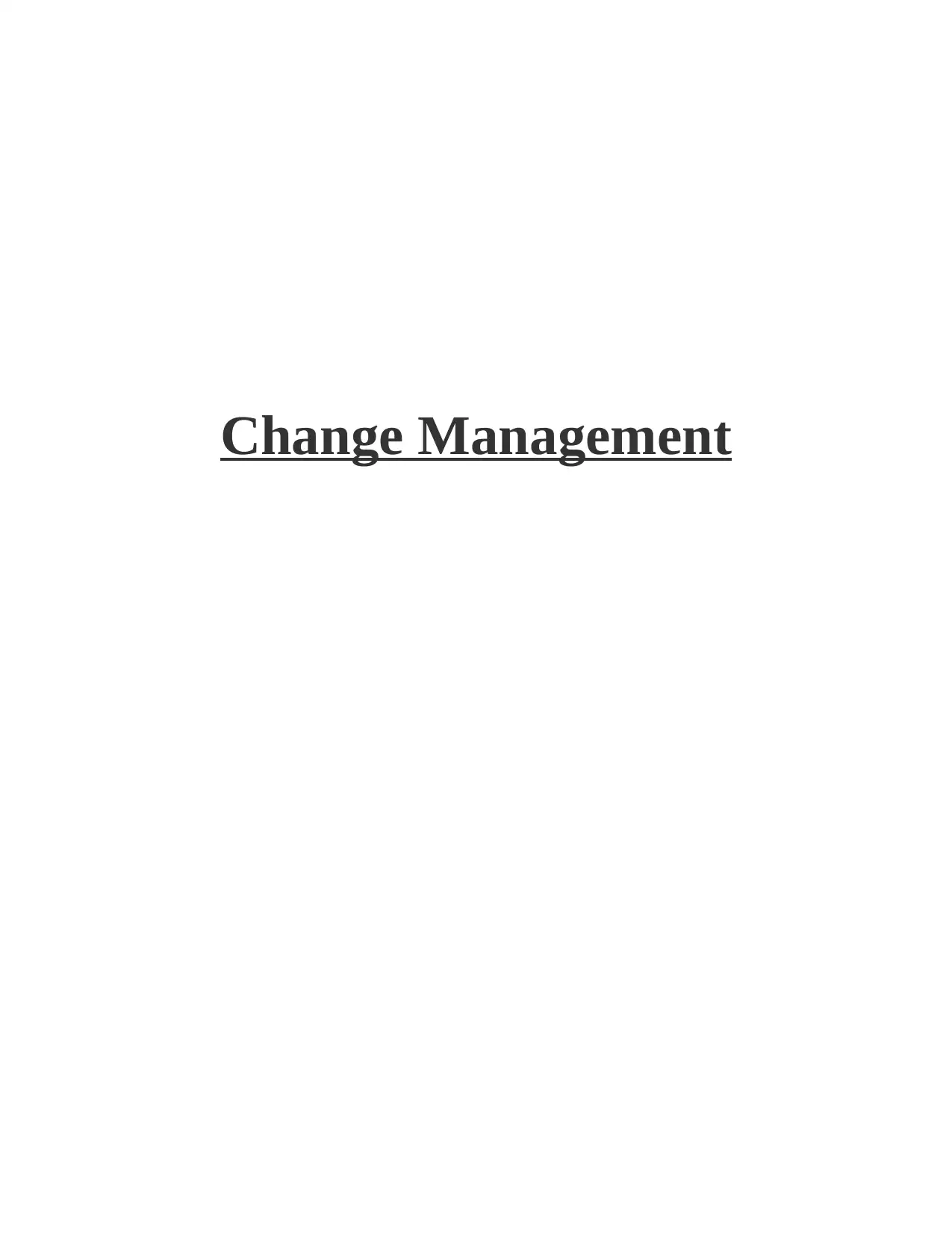
Change Management
Paraphrase This Document
Need a fresh take? Get an instant paraphrase of this document with our AI Paraphraser
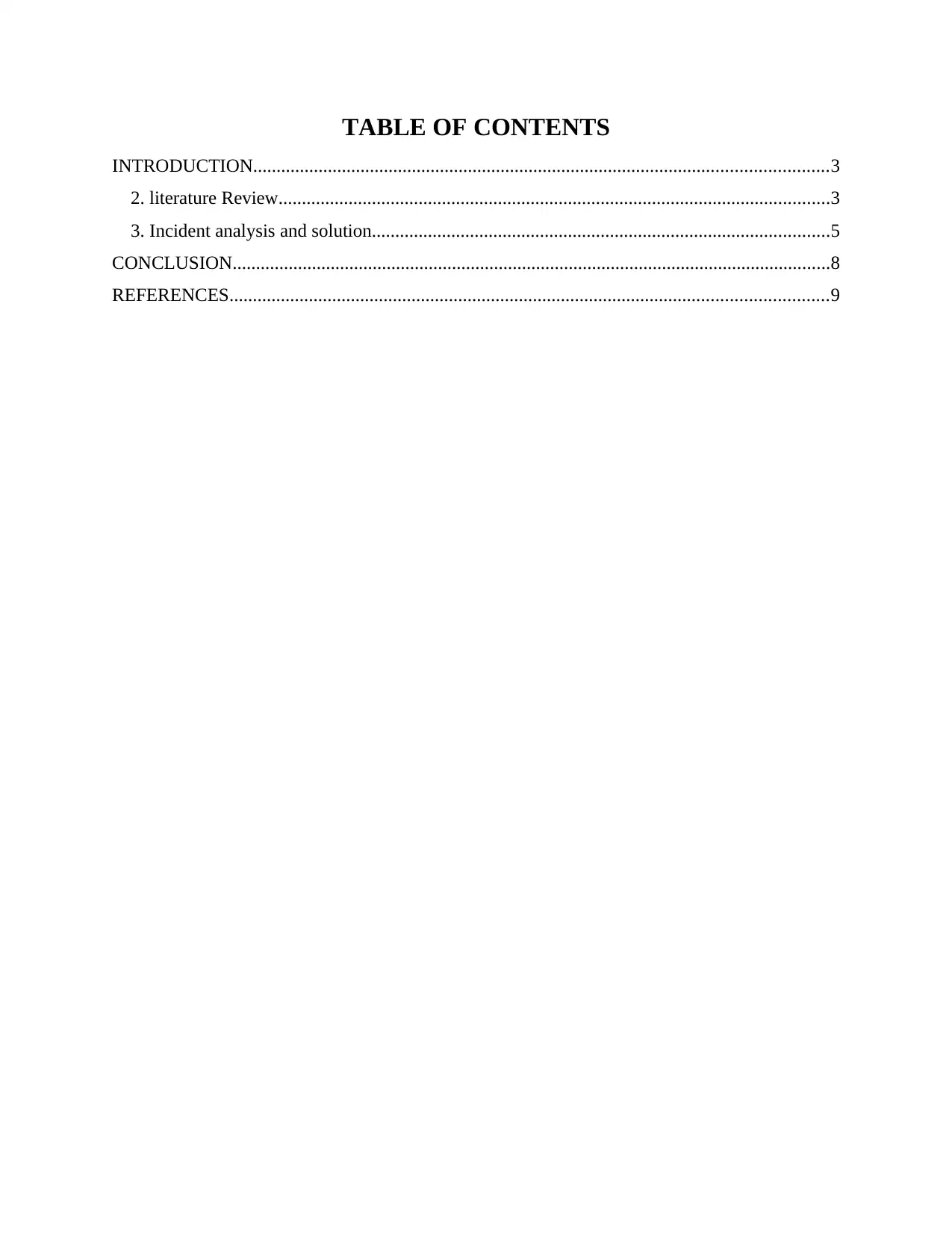
TABLE OF CONTENTS
INTRODUCTION...........................................................................................................................3
2. literature Review......................................................................................................................3
3. Incident analysis and solution..................................................................................................5
CONCLUSION................................................................................................................................8
REFERENCES................................................................................................................................9
INTRODUCTION...........................................................................................................................3
2. literature Review......................................................................................................................3
3. Incident analysis and solution..................................................................................................5
CONCLUSION................................................................................................................................8
REFERENCES................................................................................................................................9
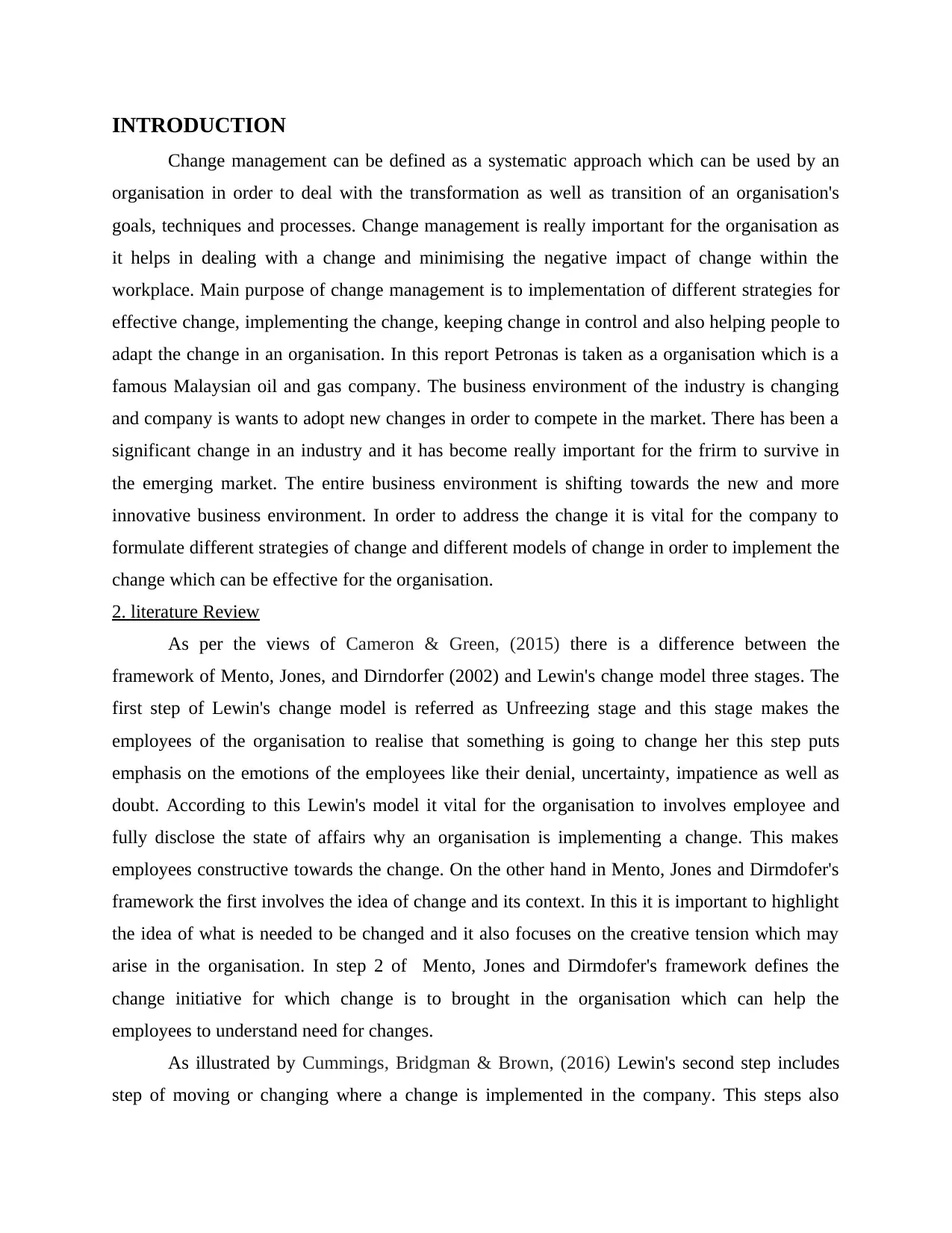
INTRODUCTION
Change management can be defined as a systematic approach which can be used by an
organisation in order to deal with the transformation as well as transition of an organisation's
goals, techniques and processes. Change management is really important for the organisation as
it helps in dealing with a change and minimising the negative impact of change within the
workplace. Main purpose of change management is to implementation of different strategies for
effective change, implementing the change, keeping change in control and also helping people to
adapt the change in an organisation. In this report Petronas is taken as a organisation which is a
famous Malaysian oil and gas company. The business environment of the industry is changing
and company is wants to adopt new changes in order to compete in the market. There has been a
significant change in an industry and it has become really important for the frirm to survive in
the emerging market. The entire business environment is shifting towards the new and more
innovative business environment. In order to address the change it is vital for the company to
formulate different strategies of change and different models of change in order to implement the
change which can be effective for the organisation.
2. literature Review
As per the views of Cameron & Green, (2015) there is a difference between the
framework of Mento, Jones, and Dirndorfer (2002) and Lewin's change model three stages. The
first step of Lewin's change model is referred as Unfreezing stage and this stage makes the
employees of the organisation to realise that something is going to change her this step puts
emphasis on the emotions of the employees like their denial, uncertainty, impatience as well as
doubt. According to this Lewin's model it vital for the organisation to involves employee and
fully disclose the state of affairs why an organisation is implementing a change. This makes
employees constructive towards the change. On the other hand in Mento, Jones and Dirmdofer's
framework the first involves the idea of change and its context. In this it is important to highlight
the idea of what is needed to be changed and it also focuses on the creative tension which may
arise in the organisation. In step 2 of Mento, Jones and Dirmdofer's framework defines the
change initiative for which change is to brought in the organisation which can help the
employees to understand need for changes.
As illustrated by Cummings, Bridgman & Brown, (2016) Lewin's second step includes
step of moving or changing where a change is implemented in the company. This steps also
Change management can be defined as a systematic approach which can be used by an
organisation in order to deal with the transformation as well as transition of an organisation's
goals, techniques and processes. Change management is really important for the organisation as
it helps in dealing with a change and minimising the negative impact of change within the
workplace. Main purpose of change management is to implementation of different strategies for
effective change, implementing the change, keeping change in control and also helping people to
adapt the change in an organisation. In this report Petronas is taken as a organisation which is a
famous Malaysian oil and gas company. The business environment of the industry is changing
and company is wants to adopt new changes in order to compete in the market. There has been a
significant change in an industry and it has become really important for the frirm to survive in
the emerging market. The entire business environment is shifting towards the new and more
innovative business environment. In order to address the change it is vital for the company to
formulate different strategies of change and different models of change in order to implement the
change which can be effective for the organisation.
2. literature Review
As per the views of Cameron & Green, (2015) there is a difference between the
framework of Mento, Jones, and Dirndorfer (2002) and Lewin's change model three stages. The
first step of Lewin's change model is referred as Unfreezing stage and this stage makes the
employees of the organisation to realise that something is going to change her this step puts
emphasis on the emotions of the employees like their denial, uncertainty, impatience as well as
doubt. According to this Lewin's model it vital for the organisation to involves employee and
fully disclose the state of affairs why an organisation is implementing a change. This makes
employees constructive towards the change. On the other hand in Mento, Jones and Dirmdofer's
framework the first involves the idea of change and its context. In this it is important to highlight
the idea of what is needed to be changed and it also focuses on the creative tension which may
arise in the organisation. In step 2 of Mento, Jones and Dirmdofer's framework defines the
change initiative for which change is to brought in the organisation which can help the
employees to understand need for changes.
As illustrated by Cummings, Bridgman & Brown, (2016) Lewin's second step includes
step of moving or changing where a change is implemented in the company. This steps also
⊘ This is a preview!⊘
Do you want full access?
Subscribe today to unlock all pages.

Trusted by 1+ million students worldwide
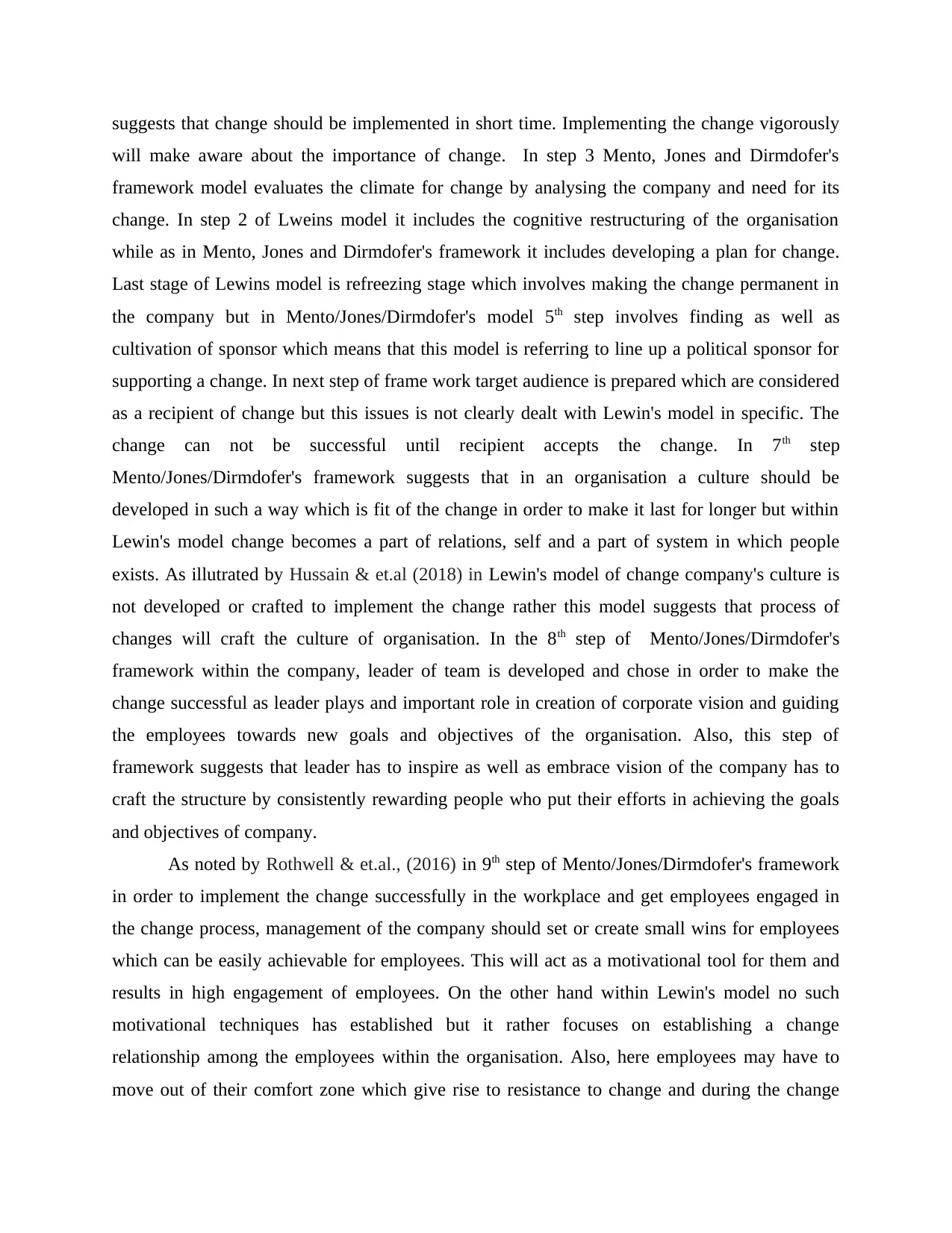
suggests that change should be implemented in short time. Implementing the change vigorously
will make aware about the importance of change. In step 3 Mento, Jones and Dirmdofer's
framework model evaluates the climate for change by analysing the company and need for its
change. In step 2 of Lweins model it includes the cognitive restructuring of the organisation
while as in Mento, Jones and Dirmdofer's framework it includes developing a plan for change.
Last stage of Lewins model is refreezing stage which involves making the change permanent in
the company but in Mento/Jones/Dirmdofer's model 5th step involves finding as well as
cultivation of sponsor which means that this model is referring to line up a political sponsor for
supporting a change. In next step of frame work target audience is prepared which are considered
as a recipient of change but this issues is not clearly dealt with Lewin's model in specific. The
change can not be successful until recipient accepts the change. In 7th step
Mento/Jones/Dirmdofer's framework suggests that in an organisation a culture should be
developed in such a way which is fit of the change in order to make it last for longer but within
Lewin's model change becomes a part of relations, self and a part of system in which people
exists. As illutrated by Hussain & et.al (2018) in Lewin's model of change company's culture is
not developed or crafted to implement the change rather this model suggests that process of
changes will craft the culture of organisation. In the 8th step of Mento/Jones/Dirmdofer's
framework within the company, leader of team is developed and chose in order to make the
change successful as leader plays and important role in creation of corporate vision and guiding
the employees towards new goals and objectives of the organisation. Also, this step of
framework suggests that leader has to inspire as well as embrace vision of the company has to
craft the structure by consistently rewarding people who put their efforts in achieving the goals
and objectives of company.
As noted by Rothwell & et.al., (2016) in 9th step of Mento/Jones/Dirmdofer's framework
in order to implement the change successfully in the workplace and get employees engaged in
the change process, management of the company should set or create small wins for employees
which can be easily achievable for employees. This will act as a motivational tool for them and
results in high engagement of employees. On the other hand within Lewin's model no such
motivational techniques has established but it rather focuses on establishing a change
relationship among the employees within the organisation. Also, here employees may have to
move out of their comfort zone which give rise to resistance to change and during the change
will make aware about the importance of change. In step 3 Mento, Jones and Dirmdofer's
framework model evaluates the climate for change by analysing the company and need for its
change. In step 2 of Lweins model it includes the cognitive restructuring of the organisation
while as in Mento, Jones and Dirmdofer's framework it includes developing a plan for change.
Last stage of Lewins model is refreezing stage which involves making the change permanent in
the company but in Mento/Jones/Dirmdofer's model 5th step involves finding as well as
cultivation of sponsor which means that this model is referring to line up a political sponsor for
supporting a change. In next step of frame work target audience is prepared which are considered
as a recipient of change but this issues is not clearly dealt with Lewin's model in specific. The
change can not be successful until recipient accepts the change. In 7th step
Mento/Jones/Dirmdofer's framework suggests that in an organisation a culture should be
developed in such a way which is fit of the change in order to make it last for longer but within
Lewin's model change becomes a part of relations, self and a part of system in which people
exists. As illutrated by Hussain & et.al (2018) in Lewin's model of change company's culture is
not developed or crafted to implement the change rather this model suggests that process of
changes will craft the culture of organisation. In the 8th step of Mento/Jones/Dirmdofer's
framework within the company, leader of team is developed and chose in order to make the
change successful as leader plays and important role in creation of corporate vision and guiding
the employees towards new goals and objectives of the organisation. Also, this step of
framework suggests that leader has to inspire as well as embrace vision of the company has to
craft the structure by consistently rewarding people who put their efforts in achieving the goals
and objectives of company.
As noted by Rothwell & et.al., (2016) in 9th step of Mento/Jones/Dirmdofer's framework
in order to implement the change successfully in the workplace and get employees engaged in
the change process, management of the company should set or create small wins for employees
which can be easily achievable for employees. This will act as a motivational tool for them and
results in high engagement of employees. On the other hand within Lewin's model no such
motivational techniques has established but it rather focuses on establishing a change
relationship among the employees within the organisation. Also, here employees may have to
move out of their comfort zone which give rise to resistance to change and during the change
Paraphrase This Document
Need a fresh take? Get an instant paraphrase of this document with our AI Paraphraser
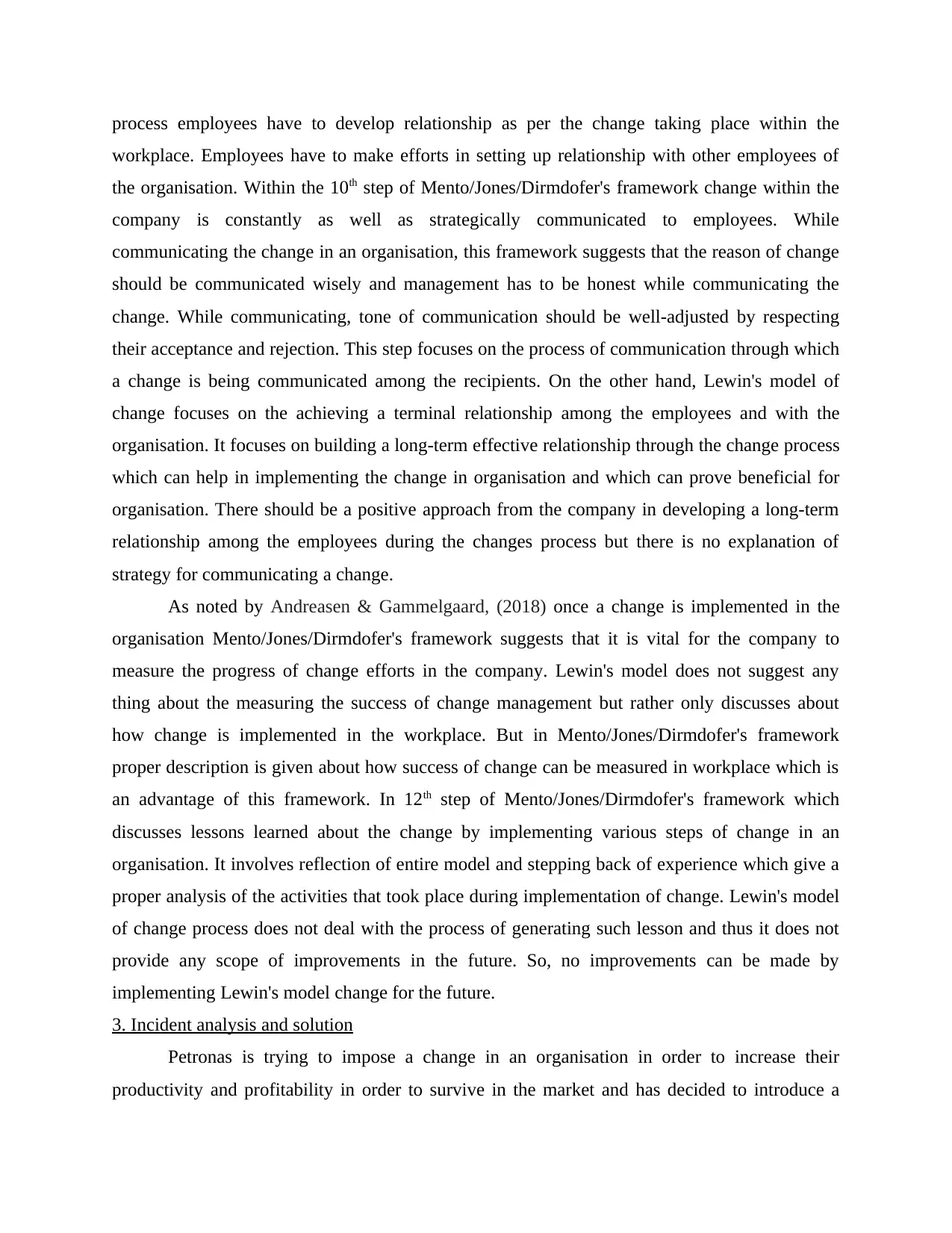
process employees have to develop relationship as per the change taking place within the
workplace. Employees have to make efforts in setting up relationship with other employees of
the organisation. Within the 10th step of Mento/Jones/Dirmdofer's framework change within the
company is constantly as well as strategically communicated to employees. While
communicating the change in an organisation, this framework suggests that the reason of change
should be communicated wisely and management has to be honest while communicating the
change. While communicating, tone of communication should be well-adjusted by respecting
their acceptance and rejection. This step focuses on the process of communication through which
a change is being communicated among the recipients. On the other hand, Lewin's model of
change focuses on the achieving a terminal relationship among the employees and with the
organisation. It focuses on building a long-term effective relationship through the change process
which can help in implementing the change in organisation and which can prove beneficial for
organisation. There should be a positive approach from the company in developing a long-term
relationship among the employees during the changes process but there is no explanation of
strategy for communicating a change.
As noted by Andreasen & Gammelgaard, (2018) once a change is implemented in the
organisation Mento/Jones/Dirmdofer's framework suggests that it is vital for the company to
measure the progress of change efforts in the company. Lewin's model does not suggest any
thing about the measuring the success of change management but rather only discusses about
how change is implemented in the workplace. But in Mento/Jones/Dirmdofer's framework
proper description is given about how success of change can be measured in workplace which is
an advantage of this framework. In 12th step of Mento/Jones/Dirmdofer's framework which
discusses lessons learned about the change by implementing various steps of change in an
organisation. It involves reflection of entire model and stepping back of experience which give a
proper analysis of the activities that took place during implementation of change. Lewin's model
of change process does not deal with the process of generating such lesson and thus it does not
provide any scope of improvements in the future. So, no improvements can be made by
implementing Lewin's model change for the future.
3. Incident analysis and solution
Petronas is trying to impose a change in an organisation in order to increase their
productivity and profitability in order to survive in the market and has decided to introduce a
workplace. Employees have to make efforts in setting up relationship with other employees of
the organisation. Within the 10th step of Mento/Jones/Dirmdofer's framework change within the
company is constantly as well as strategically communicated to employees. While
communicating the change in an organisation, this framework suggests that the reason of change
should be communicated wisely and management has to be honest while communicating the
change. While communicating, tone of communication should be well-adjusted by respecting
their acceptance and rejection. This step focuses on the process of communication through which
a change is being communicated among the recipients. On the other hand, Lewin's model of
change focuses on the achieving a terminal relationship among the employees and with the
organisation. It focuses on building a long-term effective relationship through the change process
which can help in implementing the change in organisation and which can prove beneficial for
organisation. There should be a positive approach from the company in developing a long-term
relationship among the employees during the changes process but there is no explanation of
strategy for communicating a change.
As noted by Andreasen & Gammelgaard, (2018) once a change is implemented in the
organisation Mento/Jones/Dirmdofer's framework suggests that it is vital for the company to
measure the progress of change efforts in the company. Lewin's model does not suggest any
thing about the measuring the success of change management but rather only discusses about
how change is implemented in the workplace. But in Mento/Jones/Dirmdofer's framework
proper description is given about how success of change can be measured in workplace which is
an advantage of this framework. In 12th step of Mento/Jones/Dirmdofer's framework which
discusses lessons learned about the change by implementing various steps of change in an
organisation. It involves reflection of entire model and stepping back of experience which give a
proper analysis of the activities that took place during implementation of change. Lewin's model
of change process does not deal with the process of generating such lesson and thus it does not
provide any scope of improvements in the future. So, no improvements can be made by
implementing Lewin's model change for the future.
3. Incident analysis and solution
Petronas is trying to impose a change in an organisation in order to increase their
productivity and profitability in order to survive in the market and has decided to introduce a
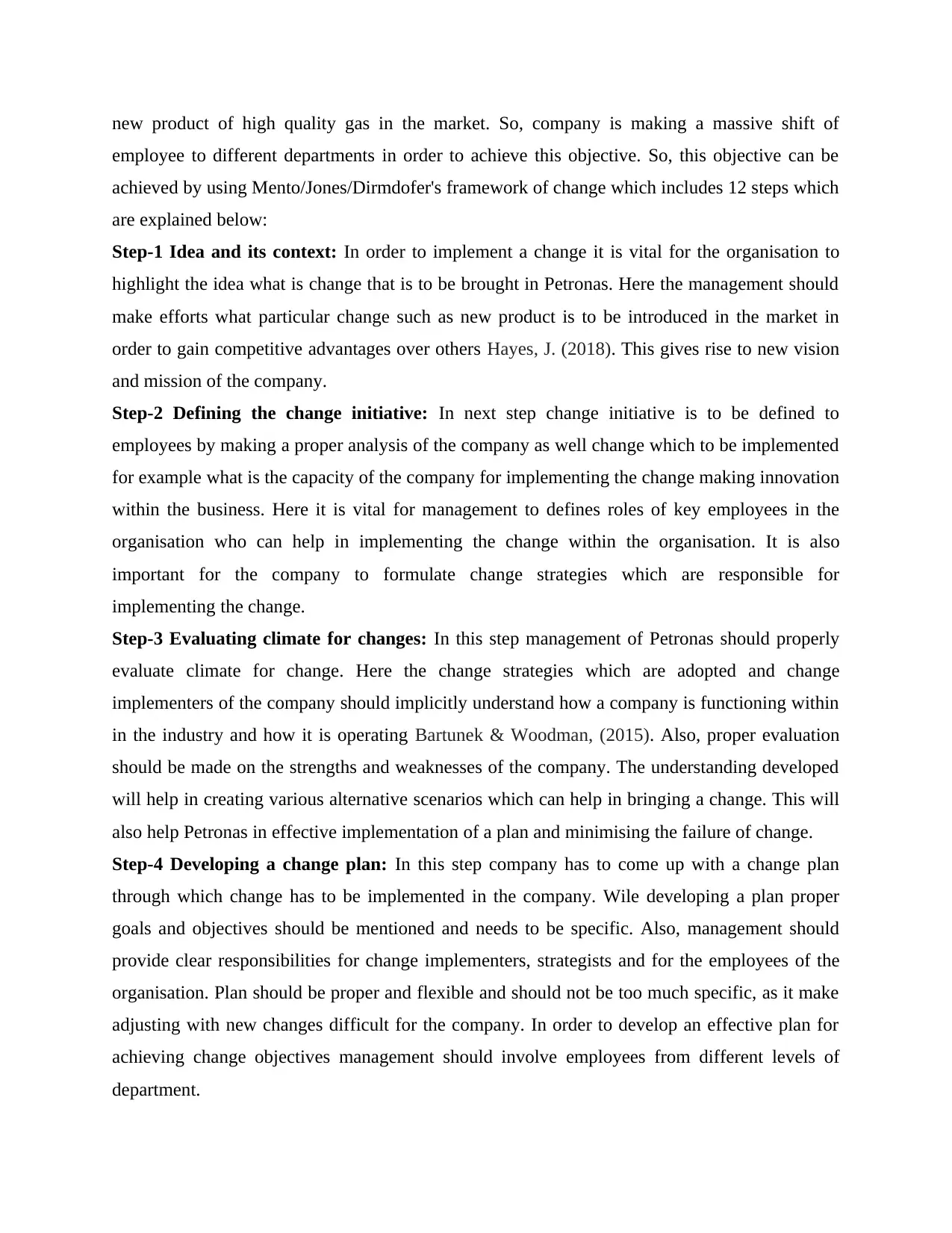
new product of high quality gas in the market. So, company is making a massive shift of
employee to different departments in order to achieve this objective. So, this objective can be
achieved by using Mento/Jones/Dirmdofer's framework of change which includes 12 steps which
are explained below:
Step-1 Idea and its context: In order to implement a change it is vital for the organisation to
highlight the idea what is change that is to be brought in Petronas. Here the management should
make efforts what particular change such as new product is to be introduced in the market in
order to gain competitive advantages over others Hayes, J. (2018). This gives rise to new vision
and mission of the company.
Step-2 Defining the change initiative: In next step change initiative is to be defined to
employees by making a proper analysis of the company as well change which to be implemented
for example what is the capacity of the company for implementing the change making innovation
within the business. Here it is vital for management to defines roles of key employees in the
organisation who can help in implementing the change within the organisation. It is also
important for the company to formulate change strategies which are responsible for
implementing the change.
Step-3 Evaluating climate for changes: In this step management of Petronas should properly
evaluate climate for change. Here the change strategies which are adopted and change
implementers of the company should implicitly understand how a company is functioning within
in the industry and how it is operating Bartunek & Woodman, (2015). Also, proper evaluation
should be made on the strengths and weaknesses of the company. The understanding developed
will help in creating various alternative scenarios which can help in bringing a change. This will
also help Petronas in effective implementation of a plan and minimising the failure of change.
Step-4 Developing a change plan: In this step company has to come up with a change plan
through which change has to be implemented in the company. Wile developing a plan proper
goals and objectives should be mentioned and needs to be specific. Also, management should
provide clear responsibilities for change implementers, strategists and for the employees of the
organisation. Plan should be proper and flexible and should not be too much specific, as it make
adjusting with new changes difficult for the company. In order to develop an effective plan for
achieving change objectives management should involve employees from different levels of
department.
employee to different departments in order to achieve this objective. So, this objective can be
achieved by using Mento/Jones/Dirmdofer's framework of change which includes 12 steps which
are explained below:
Step-1 Idea and its context: In order to implement a change it is vital for the organisation to
highlight the idea what is change that is to be brought in Petronas. Here the management should
make efforts what particular change such as new product is to be introduced in the market in
order to gain competitive advantages over others Hayes, J. (2018). This gives rise to new vision
and mission of the company.
Step-2 Defining the change initiative: In next step change initiative is to be defined to
employees by making a proper analysis of the company as well change which to be implemented
for example what is the capacity of the company for implementing the change making innovation
within the business. Here it is vital for management to defines roles of key employees in the
organisation who can help in implementing the change within the organisation. It is also
important for the company to formulate change strategies which are responsible for
implementing the change.
Step-3 Evaluating climate for changes: In this step management of Petronas should properly
evaluate climate for change. Here the change strategies which are adopted and change
implementers of the company should implicitly understand how a company is functioning within
in the industry and how it is operating Bartunek & Woodman, (2015). Also, proper evaluation
should be made on the strengths and weaknesses of the company. The understanding developed
will help in creating various alternative scenarios which can help in bringing a change. This will
also help Petronas in effective implementation of a plan and minimising the failure of change.
Step-4 Developing a change plan: In this step company has to come up with a change plan
through which change has to be implemented in the company. Wile developing a plan proper
goals and objectives should be mentioned and needs to be specific. Also, management should
provide clear responsibilities for change implementers, strategists and for the employees of the
organisation. Plan should be proper and flexible and should not be too much specific, as it make
adjusting with new changes difficult for the company. In order to develop an effective plan for
achieving change objectives management should involve employees from different levels of
department.
⊘ This is a preview!⊘
Do you want full access?
Subscribe today to unlock all pages.

Trusted by 1+ million students worldwide
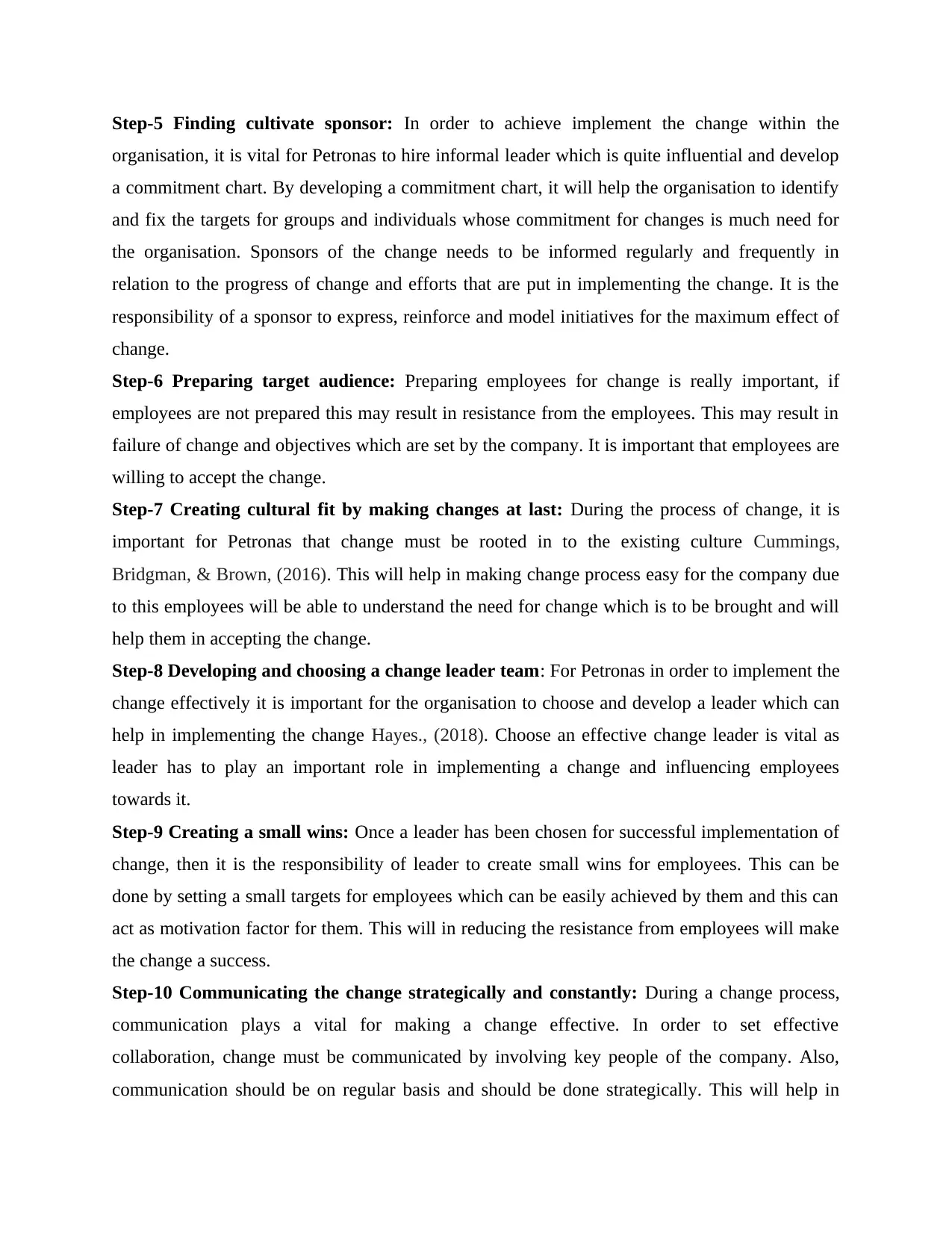
Step-5 Finding cultivate sponsor: In order to achieve implement the change within the
organisation, it is vital for Petronas to hire informal leader which is quite influential and develop
a commitment chart. By developing a commitment chart, it will help the organisation to identify
and fix the targets for groups and individuals whose commitment for changes is much need for
the organisation. Sponsors of the change needs to be informed regularly and frequently in
relation to the progress of change and efforts that are put in implementing the change. It is the
responsibility of a sponsor to express, reinforce and model initiatives for the maximum effect of
change.
Step-6 Preparing target audience: Preparing employees for change is really important, if
employees are not prepared this may result in resistance from the employees. This may result in
failure of change and objectives which are set by the company. It is important that employees are
willing to accept the change.
Step-7 Creating cultural fit by making changes at last: During the process of change, it is
important for Petronas that change must be rooted in to the existing culture Cummings,
Bridgman, & Brown, (2016). This will help in making change process easy for the company due
to this employees will be able to understand the need for change which is to be brought and will
help them in accepting the change.
Step-8 Developing and choosing a change leader team: For Petronas in order to implement the
change effectively it is important for the organisation to choose and develop a leader which can
help in implementing the change Hayes., (2018). Choose an effective change leader is vital as
leader has to play an important role in implementing a change and influencing employees
towards it.
Step-9 Creating a small wins: Once a leader has been chosen for successful implementation of
change, then it is the responsibility of leader to create small wins for employees. This can be
done by setting a small targets for employees which can be easily achieved by them and this can
act as motivation factor for them. This will in reducing the resistance from employees will make
the change a success.
Step-10 Communicating the change strategically and constantly: During a change process,
communication plays a vital for making a change effective. In order to set effective
collaboration, change must be communicated by involving key people of the company. Also,
communication should be on regular basis and should be done strategically. This will help in
organisation, it is vital for Petronas to hire informal leader which is quite influential and develop
a commitment chart. By developing a commitment chart, it will help the organisation to identify
and fix the targets for groups and individuals whose commitment for changes is much need for
the organisation. Sponsors of the change needs to be informed regularly and frequently in
relation to the progress of change and efforts that are put in implementing the change. It is the
responsibility of a sponsor to express, reinforce and model initiatives for the maximum effect of
change.
Step-6 Preparing target audience: Preparing employees for change is really important, if
employees are not prepared this may result in resistance from the employees. This may result in
failure of change and objectives which are set by the company. It is important that employees are
willing to accept the change.
Step-7 Creating cultural fit by making changes at last: During the process of change, it is
important for Petronas that change must be rooted in to the existing culture Cummings,
Bridgman, & Brown, (2016). This will help in making change process easy for the company due
to this employees will be able to understand the need for change which is to be brought and will
help them in accepting the change.
Step-8 Developing and choosing a change leader team: For Petronas in order to implement the
change effectively it is important for the organisation to choose and develop a leader which can
help in implementing the change Hayes., (2018). Choose an effective change leader is vital as
leader has to play an important role in implementing a change and influencing employees
towards it.
Step-9 Creating a small wins: Once a leader has been chosen for successful implementation of
change, then it is the responsibility of leader to create small wins for employees. This can be
done by setting a small targets for employees which can be easily achieved by them and this can
act as motivation factor for them. This will in reducing the resistance from employees will make
the change a success.
Step-10 Communicating the change strategically and constantly: During a change process,
communication plays a vital for making a change effective. In order to set effective
collaboration, change must be communicated by involving key people of the company. Also,
communication should be on regular basis and should be done strategically. This will help in
Paraphrase This Document
Need a fresh take? Get an instant paraphrase of this document with our AI Paraphraser
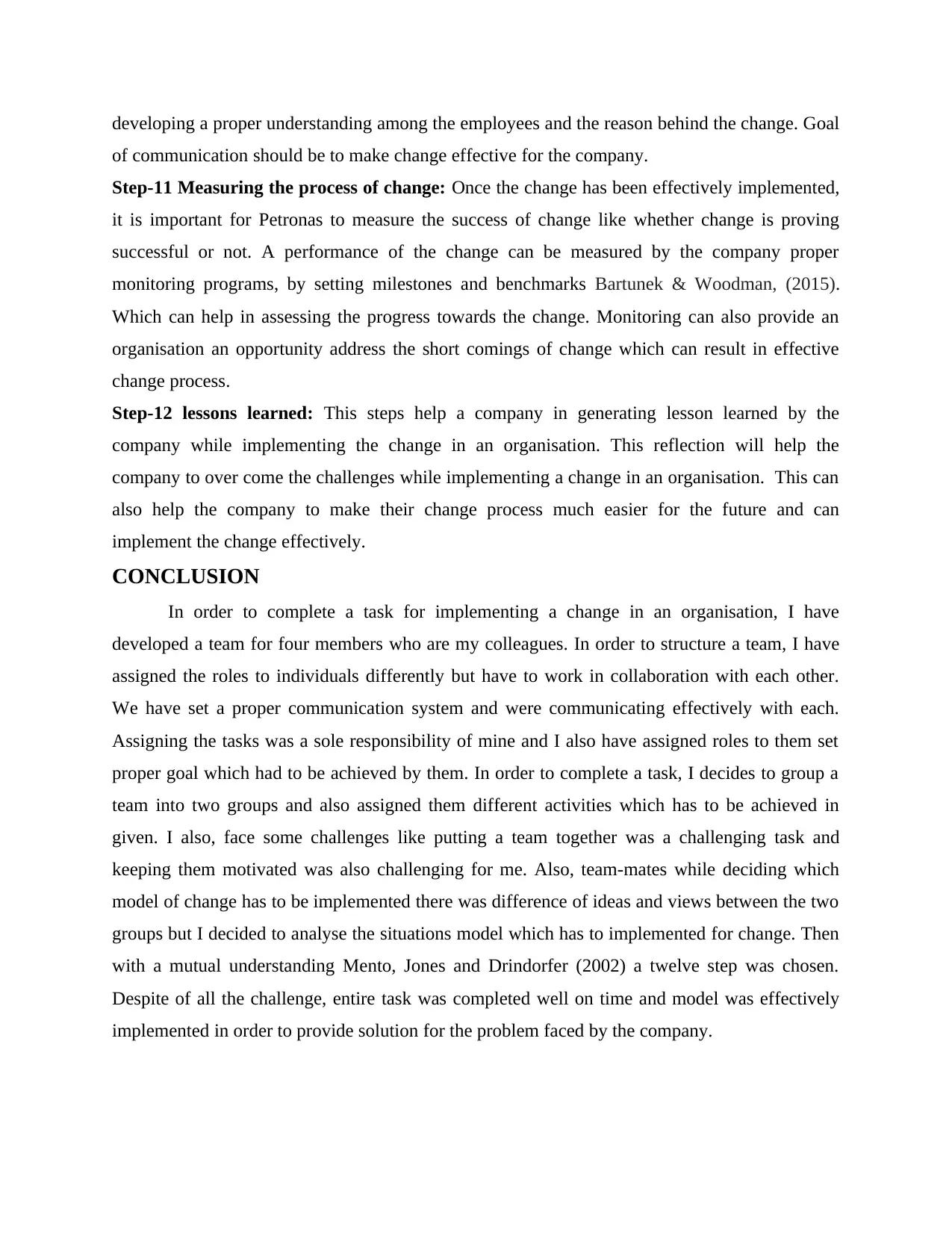
developing a proper understanding among the employees and the reason behind the change. Goal
of communication should be to make change effective for the company.
Step-11 Measuring the process of change: Once the change has been effectively implemented,
it is important for Petronas to measure the success of change like whether change is proving
successful or not. A performance of the change can be measured by the company proper
monitoring programs, by setting milestones and benchmarks Bartunek & Woodman, (2015).
Which can help in assessing the progress towards the change. Monitoring can also provide an
organisation an opportunity address the short comings of change which can result in effective
change process.
Step-12 lessons learned: This steps help a company in generating lesson learned by the
company while implementing the change in an organisation. This reflection will help the
company to over come the challenges while implementing a change in an organisation. This can
also help the company to make their change process much easier for the future and can
implement the change effectively.
CONCLUSION
In order to complete a task for implementing a change in an organisation, I have
developed a team for four members who are my colleagues. In order to structure a team, I have
assigned the roles to individuals differently but have to work in collaboration with each other.
We have set a proper communication system and were communicating effectively with each.
Assigning the tasks was a sole responsibility of mine and I also have assigned roles to them set
proper goal which had to be achieved by them. In order to complete a task, I decides to group a
team into two groups and also assigned them different activities which has to be achieved in
given. I also, face some challenges like putting a team together was a challenging task and
keeping them motivated was also challenging for me. Also, team-mates while deciding which
model of change has to be implemented there was difference of ideas and views between the two
groups but I decided to analyse the situations model which has to implemented for change. Then
with a mutual understanding Mento, Jones and Drindorfer (2002) a twelve step was chosen.
Despite of all the challenge, entire task was completed well on time and model was effectively
implemented in order to provide solution for the problem faced by the company.
of communication should be to make change effective for the company.
Step-11 Measuring the process of change: Once the change has been effectively implemented,
it is important for Petronas to measure the success of change like whether change is proving
successful or not. A performance of the change can be measured by the company proper
monitoring programs, by setting milestones and benchmarks Bartunek & Woodman, (2015).
Which can help in assessing the progress towards the change. Monitoring can also provide an
organisation an opportunity address the short comings of change which can result in effective
change process.
Step-12 lessons learned: This steps help a company in generating lesson learned by the
company while implementing the change in an organisation. This reflection will help the
company to over come the challenges while implementing a change in an organisation. This can
also help the company to make their change process much easier for the future and can
implement the change effectively.
CONCLUSION
In order to complete a task for implementing a change in an organisation, I have
developed a team for four members who are my colleagues. In order to structure a team, I have
assigned the roles to individuals differently but have to work in collaboration with each other.
We have set a proper communication system and were communicating effectively with each.
Assigning the tasks was a sole responsibility of mine and I also have assigned roles to them set
proper goal which had to be achieved by them. In order to complete a task, I decides to group a
team into two groups and also assigned them different activities which has to be achieved in
given. I also, face some challenges like putting a team together was a challenging task and
keeping them motivated was also challenging for me. Also, team-mates while deciding which
model of change has to be implemented there was difference of ideas and views between the two
groups but I decided to analyse the situations model which has to implemented for change. Then
with a mutual understanding Mento, Jones and Drindorfer (2002) a twelve step was chosen.
Despite of all the challenge, entire task was completed well on time and model was effectively
implemented in order to provide solution for the problem faced by the company.
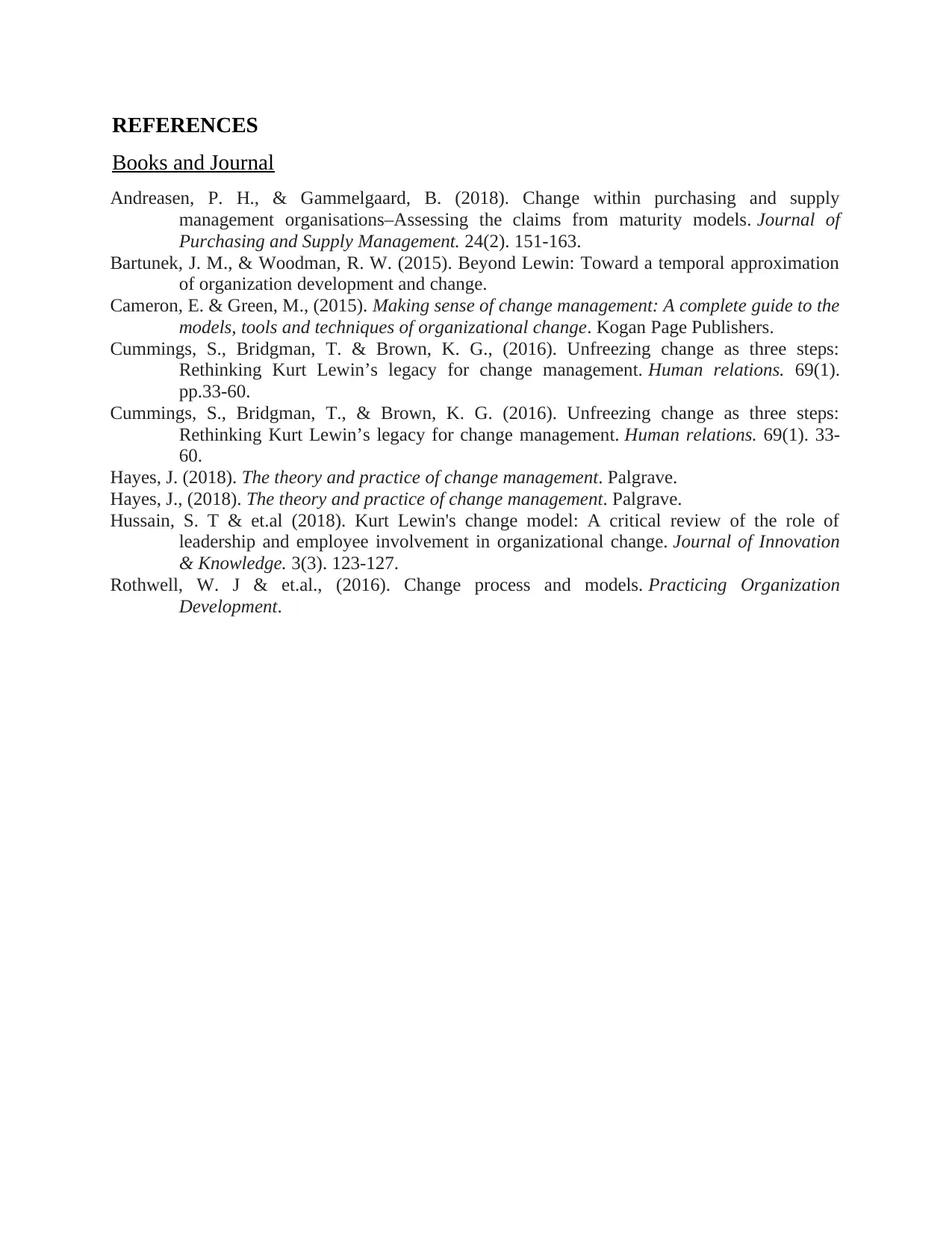
REFERENCES
Books and Journal
Andreasen, P. H., & Gammelgaard, B. (2018). Change within purchasing and supply
management organisations–Assessing the claims from maturity models. Journal of
Purchasing and Supply Management. 24(2). 151-163.
Bartunek, J. M., & Woodman, R. W. (2015). Beyond Lewin: Toward a temporal approximation
of organization development and change.
Cameron, E. & Green, M., (2015). Making sense of change management: A complete guide to the
models, tools and techniques of organizational change. Kogan Page Publishers.
Cummings, S., Bridgman, T. & Brown, K. G., (2016). Unfreezing change as three steps:
Rethinking Kurt Lewin’s legacy for change management. Human relations. 69(1).
pp.33-60.
Cummings, S., Bridgman, T., & Brown, K. G. (2016). Unfreezing change as three steps:
Rethinking Kurt Lewin’s legacy for change management. Human relations. 69(1). 33-
60.
Hayes, J. (2018). The theory and practice of change management. Palgrave.
Hayes, J., (2018). The theory and practice of change management. Palgrave.
Hussain, S. T & et.al (2018). Kurt Lewin's change model: A critical review of the role of
leadership and employee involvement in organizational change. Journal of Innovation
& Knowledge. 3(3). 123-127.
Rothwell, W. J & et.al., (2016). Change process and models. Practicing Organization
Development.
Books and Journal
Andreasen, P. H., & Gammelgaard, B. (2018). Change within purchasing and supply
management organisations–Assessing the claims from maturity models. Journal of
Purchasing and Supply Management. 24(2). 151-163.
Bartunek, J. M., & Woodman, R. W. (2015). Beyond Lewin: Toward a temporal approximation
of organization development and change.
Cameron, E. & Green, M., (2015). Making sense of change management: A complete guide to the
models, tools and techniques of organizational change. Kogan Page Publishers.
Cummings, S., Bridgman, T. & Brown, K. G., (2016). Unfreezing change as three steps:
Rethinking Kurt Lewin’s legacy for change management. Human relations. 69(1).
pp.33-60.
Cummings, S., Bridgman, T., & Brown, K. G. (2016). Unfreezing change as three steps:
Rethinking Kurt Lewin’s legacy for change management. Human relations. 69(1). 33-
60.
Hayes, J. (2018). The theory and practice of change management. Palgrave.
Hayes, J., (2018). The theory and practice of change management. Palgrave.
Hussain, S. T & et.al (2018). Kurt Lewin's change model: A critical review of the role of
leadership and employee involvement in organizational change. Journal of Innovation
& Knowledge. 3(3). 123-127.
Rothwell, W. J & et.al., (2016). Change process and models. Practicing Organization
Development.
⊘ This is a preview!⊘
Do you want full access?
Subscribe today to unlock all pages.

Trusted by 1+ million students worldwide
1 out of 9
Related Documents
Your All-in-One AI-Powered Toolkit for Academic Success.
+13062052269
info@desklib.com
Available 24*7 on WhatsApp / Email
![[object Object]](/_next/static/media/star-bottom.7253800d.svg)
Unlock your academic potential
Copyright © 2020–2025 A2Z Services. All Rights Reserved. Developed and managed by ZUCOL.





